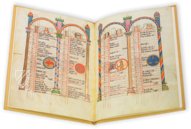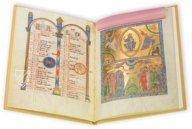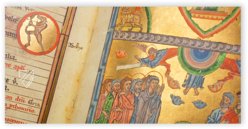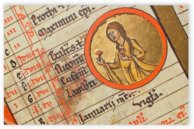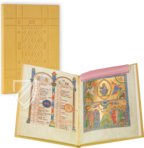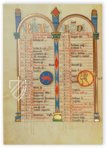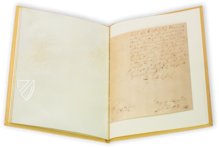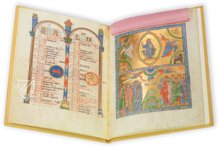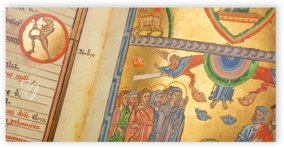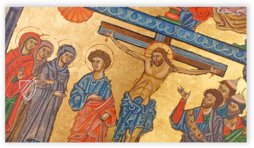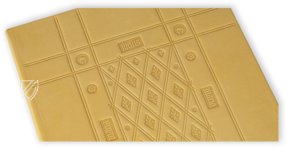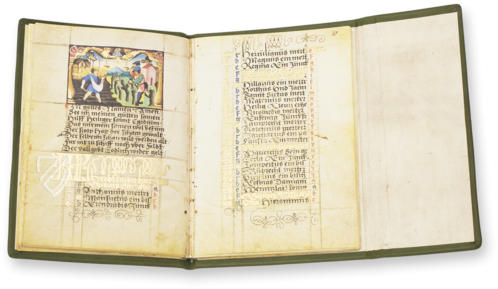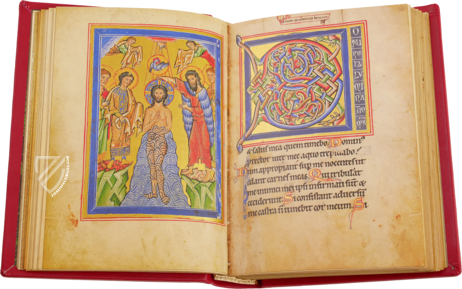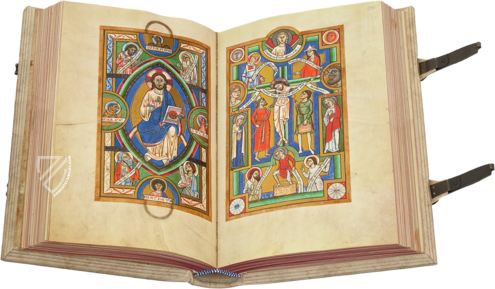Hildesheim Golden Calendar
(1,000€ - 3,000€)
This masterpiece of the Zackenstil or “jagged style” is named for its magnificent miniatures and calendar medallions with shimmering, almost magical gold backgrounds. It originated ca. 1240/1250 in the famous scriptorium at Hildesheim’s Benedictine Monastery of St. Michael, which produced some of the finest illuminated manuscripts of the period and is recognized today as a UNSESCO World Heritage Site. The manuscript contains an illustrated calendar in architectural frames with zodiac symbols as well as two full-page miniatures with five scenes from the life of Jesus Christ. Its décor is a mix of Byzantine, Romanesque, and early-Gothic influences from France and is distinguished by the highly stylized jagged or zig-zag arrangement of garment folds and contours. The Zackenstil represents a bridge between the Romanesque and Gothic styles, which was practiced in Germany and Austria during the 13th century and the Hildesheim Golden Calendar is one of its most outstanding specimens.
Hildesheim Golden Calendar
The Hildesheim Golden Calendar is counted among the masterpieces of 13th century Saxon illumination. The magnificent early-Gothic manuscript made for the Quedlinburg Abbey originated in the St. Michael’s Benedictine Monastery in Hildesheim. A complete calendar as well as five miniatures concerning the life of Jesus Christ are to be found on nine pages. The artistic layout is in the so-called Zackenstil and was completed using luxurious gold.
A Splendid Example of Hildesheim Illumination
Against a splendid gold background that produces an almost magical effect, scenes play out with figures dressed in colorful clothes. A handsome, elegant angel proclaims the birth of the Lord to Mary, the cross with Christ dominates an impressive crucifixion scene, and a colorful crowd of people watches the Ascension of Christ in astonishment. These magnificent miniatures were made ca. 1240/1250 in Hildesheim’s Benedictine Monastery of St. Michael. The scriptorium there is famous for its excellent works, above all the Stammheim Missal (residing in the J. Paul Getty Museum, Los Angeles), that may have served as an example for the Hildesheim Golden Calendar. The calendar manuscript was intended for the Quedlinburg Abbey. In the Middle Ages, St. Michael’s Benedictine Monastery in Hildesheim was one of the most important abbeys in Europe, which was also known as a production site for great art. The historical significance of the place where the Hildesheim Golden Calendar was manufactured in Lower Saxony is also evidenced through the recognition of St. Michael’s Monastery together with the Hildesheim Cathedral as a UNSESCO World Heritage Site.
A Golden Book with Byzantine Echoes
The total of 16 pages in the large-format manuscript also contains, next to seven pages with a complete calendar, two illustrated pages with a total of 5 miniatures from the life of Jesus Christ. These are in the so-called Zackenstil, which arose at the beginning of the 13th century. The paintings of the Hildesheim Golden Calendar distinguish themselves through marked echoes from Byzantine art, which converged with Romanesque and French early-Gothic influences. Thus originates, for example, the extremely interesting garments of the figures depicted with their manifold arrangement of folds. Also worth a look is the powerful ornamental embellishment of the pictorial scenes with adjusted columns and the conspicuous framework. This ornamental adornment is particularly expressed by the calendar pages. There one finds two months next to each other on one page, respectively. They are integrated in a splendid arcade framing, which is crowned with architectural elements, small turrets in various forms. Artistically varying patterns and colors give the frames a particular flavor. The calendar pages were rounded off through the attached zodiac signs in a partially gilded medallion. The great artistry of the painter, who worked with wonderful colors and a great deal of gold, is also manifest here.
A Well-Preserved Gothic Masterpiece
The calendar’s text is configured in red and black script, which underlines the diverse character of the entire manuscript. The silk curtains affixed between the pages for the protection of the splendid pictorial pages are a distinct feature of the Hildesheim Golden Calendar. Today the magnificent manuscript is housed in the Herzog August Library in Wolfenbüttel. Without a doubt, it is considered to be, along with its artistic pictorial pages, among the most beautiful German manuscripts from the 13th century and is called the Hildesheim Golden Calendar for a reason.
Codicology
- Alternative Titles
- Das Goldene Hildesheimer Kalendarium
Il Calendario d'Oro di Hildesheim
Goldenes Hildesheimer Kalendarium - Size / Format
- 16 pages / 30.9 × 22.5 cm
- Origin
- Germany
- Date
- Ca. 1250
- Style
- Genre
- Language
- Script
- Gothic
- Illustrations
- 2 full-page miniatures and complete calender with elaborately designed zodiac signs
- Content
- Lavishly adorned calendar with plentiful gold leaf
- Artist / School
- Zackenstil (jagged style)
Hildesheim Golden Calendar
Scorpio and Sagittarius
These two fine zodiac symbols are enclosed in medallion miniatures and interspersed with the important calendars dates for November and December, which are finely written in red and black ink. Scorpio is presented simply before a starry blue sky in a ring of gold, but Sagittarius is considerably more elaborate with detailed musculature and a shimmering gold background. Rather than being depicted as a centaur, Sagittarius is a drollery with the body of a man and the head of a wolf.

Hildesheim Golden Calendar
Vita Christi
This outstanding full-page miniature is broken up into three important scenes from the life of Christ, all presented before a sparkling gold background. Going clockwise from the top left, they are the Annunciation, Adoration of the Magi, and Crucifixion. The upper scenes are divided by a Roman column, while the lower scene is separated by a blue bar with arabesques.
The garments are a fine example of the German Zackenstil or “jagged style”, especially Mary’s cloak in the Adoration scene, which is being used as a blanket. The Pharisees are depicted in rich garments in a more contemporary style with tights, while Christ’s followers wear classical togas. Byzantine artistic influences are evident in the standardized faces and emotive hand gestures.

#1 Das Goldene Hildesheimer Kalendarium
Language: German
(1,000€ - 3,000€)
#2 Il Calendario d'Oro di Hildesheim
(1,000€ - 3,000€)
- Treatises / Secular Books
- Apocalypses / Beatus
- Astronomy / Astrology
- Bestiaries
- Bibles / Gospels
- Chronicles / History / Law
- Geography / Maps
- Saints' Lives
- Islam / Oriental
- Judaism / Hebrew
- Single Leaf Collections
- Leonardo da Vinci
- Literature / Poetry
- Liturgical Manuscripts
- Medicine / Botany / Alchemy
- Music
- Mythology / Prophecies
- Psalters
- Other Religious Books
- Games / Hunting
- Private Devotion Books
- Other Genres
- Afghanistan
- Armenia
- Austria
- Belgium
- Belize
- Bosnia and Herzegovina
- China
- Colombia
- Costa Rica
- Croatia
- Cyprus
- Czech Republic
- Denmark
- Egypt
- El Salvador
- Ethiopia
- France
- Germany
- Greece
- Guatemala
- Honduras
- Hungary
- India
- Iran
- Iraq
- Israel
- Italy
- Japan
- Jordan
- Kazakhstan
- Kyrgyzstan
- Lebanon
- Liechtenstein
- Luxembourg
- Mexico
- Morocco
- Netherlands
- Palestine
- Panama
- Peru
- Poland
- Portugal
- Romania
- Russia
- Serbia
- Spain
- Sri Lanka
- Sweden
- Switzerland
- Syria
- Tajikistan
- Turkey
- Turkmenistan
- Ukraine
- United Kingdom
- United States
- Uzbekistan
- Vatican City
- A. Oosthoek, van Holkema & Warendorf
- Aboca Museum
- Ajuntament de Valencia
- Akademie Verlag
- Akademische Druck- u. Verlagsanstalt (ADEVA)
- Aldo Ausilio Editore - Bottega d’Erasmo
- Alecto Historical Editions
- Alkuin Verlag
- Almqvist & Wiksell
- Amilcare Pizzi
- Andreas & Andreas Verlagsbuchhandlung
- Archa 90
- Archiv Verlag
- Archivi Edizioni
- Arnold Verlag
- ARS
- Ars Magna
- ArtCodex
- AyN Ediciones
- Azimuth Editions
- Badenia Verlag
- Bärenreiter-Verlag
- Belser Verlag
- Belser Verlag / WK Wertkontor
- Benziger Verlag
- Bernardinum Wydawnictwo
- BiblioGemma
- Biblioteca Apostolica Vaticana (Vaticanstadt, Vaticanstadt)
- Bibliotheca Palatina Faksimile Verlag
- Bibliotheca Rara
- Boydell & Brewer
- Bramante Edizioni
- Bredius Genootschap
- Brepols Publishers
- British Library
- C. Weckesser
- Caixa Catalunya
- Canesi
- CAPSA, Ars Scriptoria
- Caratzas Brothers, Publishers
- Carus Verlag
- Casamassima Libri
- Centrum Cartographie Verlag GmbH
- Chavane Verlag
- Christian Brandstätter Verlag
- Circulo Cientifico
- Club Bibliófilo Versol
- Club du Livre
- CM Editores
- Collegium Graphicum
- Collezione Apocrifa Da Vinci
- Comissão Nacional para as Comemorações dos Descobrimentos Portugueses
- Coron Verlag
- Corvina
- CTHS
- D. S. Brewer
- Damon
- De Agostini/UTET
- De Nederlandsche Boekhandel
- De Schutter
- Deuschle & Stemmle
- Deutscher Verlag für Kunstwissenschaft
- DIAMM
- Droz
- E. Schreiber Graphische Kunstanstalten
- Ediciones Boreal
- Ediciones Grial
- Ediclube
- Edições Inapa
- Edilan
- Editalia
- Edition Deuschle
- Edition Georg Popp
- Edition Leipzig
- Edition Libri Illustri
- Editiones Reales Sitios S. L.
- Éditions de l'Oiseau Lyre
- Editions Medicina Rara
- Editorial Casariego
- Editorial Mintzoa
- Editrice Antenore
- Editrice Velar
- Edizioni Edison
- Egeria, S.L.
- Eikon Editores
- Electa
- Emery Walker Limited
- Enciclopèdia Catalana
- Eos-Verlag
- Ephesus Publishing
- Ernst Battenberg
- Eugrammia Press
- Extraordinary Editions
- Fackelverlag
- Facsimila Art & Edition
- Facsimile Editions Ltd.
- Facsimilia Art & Edition Ebert KG
- Faksimile Verlag
- Feuermann Verlag
- Folger Shakespeare Library
- Franco Cosimo Panini Editore
- Friedrich Wittig Verlag
- Fundación Hullera Vasco-Leonesa
- G. Braziller
- Gabriele Mazzotta Editore
- Gebr. Mann Verlag
- Gesellschaft für graphische Industrie
- Getty Research Institute
- Giovanni Domenico de Rossi
- Giunti Editore
- Graffiti
- Grafica European Center of Fine Arts
- Guido Pressler
- Guillermo Blazquez
- Gustav Kiepenheuer
- H. N. Abrams
- Harrassowitz
- Harvard University Press
- Helikon
- Hendrickson Publishers
- Henning Oppermann
- Herder Verlag
- Hes & De Graaf Publishers
- Hoepli
- Holbein-Verlag
- Houghton Library
- Hugo Schmidt Verlag
- Idion Verlag
- Il Bulino, edizioni d'arte
- ILte
- Imago
- Insel Verlag
- Insel-Verlag Anton Kippenberger
- Instituto de Estudios Altoaragoneses
- Instituto Nacional de Antropología e Historia
- Istituto dell'Enciclopedia Italiana - Treccani
- Istituto Ellenico di Studi Bizantini e Postbizantini
- Istituto Geografico De Agostini
- Istituto Poligrafico e Zecca dello Stato
- Italarte Art Establishments
- Jan Thorbecke Verlag
- Johnson Reprint Corporation
- Josef Stocker
- Josef Stocker-Schmid
- Jugoslavija
- Karl W. Hiersemann
- Kasper Straube
- Kaydeda Ediciones
- Kindler Verlag / Coron Verlag
- Kodansha International Ltd.
- Konrad Kölbl Verlag
- Kurt Wolff Verlag
- La Liberia dello Stato
- La Linea Editrice
- La Meta Editore
- Lambert Schneider
- Landeskreditbank Baden-Württemberg
- Leo S. Olschki
- Les Incunables
- Liber Artis
- Library of Congress
- Libreria Musicale Italiana
- Lichtdruck
- Lito Immagine Editore
- Lumen Artis
- Lund Humphries
- M. Moleiro Editor
- Maison des Sciences de l'homme et de la société de Poitiers
- Manuscriptum
- Martinus Nijhoff
- Maruzen-Yushodo Co. Ltd.
- MASA
- Massada Publishers
- McGraw-Hill
- Metropolitan Museum of Art
- Militos
- Millennium Liber
- Müller & Schindler
- Nahar - Stavit
- Nahar and Steimatzky
- National Library of Wales
- Neri Pozza
- Nova Charta
- Oceanum Verlag
- Odeon
- Orbis Mediaevalis
- Orbis Pictus
- Österreichische Staatsdruckerei
- Oxford University Press
- Pageant Books
- Parzellers Buchverlag
- Patrimonio Ediciones
- Pattloch Verlag
- PIAF
- Pieper Verlag
- Plon-Nourrit et cie
- Poligrafiche Bolis
- Presses Universitaires de Strasbourg
- Prestel Verlag
- Princeton University Press
- Prisma Verlag
- Priuli & Verlucca, editori
- Pro Sport Verlag
- Propyläen Verlag
- Pytheas Books
- Quaternio Verlag Luzern
- Reales Sitios
- Recht-Verlag
- Reichert Verlag
- Reichsdruckerei
- Reprint Verlag
- Riehn & Reusch
- Roberto Vattori Editore
- Rosenkilde and Bagger
- Roxburghe Club
- Salerno Editrice
- Saltellus Press
- Sandoz
- Sarajevo Svjetlost
- Schöck ArtPrint Kft.
- Schulsinger Brothers
- Scolar Press
- Scrinium
- Scripta Maneant
- Scriptorium
- Shazar
- Siloé, arte y bibliofilia
- SISMEL - Edizioni del Galluzzo
- Sociedad Mexicana de Antropología
- Société des Bibliophiles & Iconophiles de Belgique
- Soncin Publishing
- Sorli Ediciones
- Stainer and Bell
- Studer
- Styria Verlag
- Sumptibus Pragopress
- Szegedi Tudomànyegyetem
- Taberna Libraria
- Tarshish Books
- Taschen
- Tempus Libri
- Testimonio Compañía Editorial
- Thames and Hudson
- The Clear Vue Publishing Partnership Limited
- The Facsimile Codex
- The Folio Society
- The Marquess of Normanby
- The Richard III and Yorkist History Trust
- Tip.Le.Co
- TouchArt
- TREC Publishing House
- TRI Publishing Co.
- Trident Editore
- Typis Regiae Officinae Polygraphicae
- Union Verlag Berlin
- Universidad de Granada
- University of California Press
- University of Chicago Press
- Urs Graf
- Vallecchi
- Van Wijnen
- VCH, Acta Humaniora
- VDI Verlag
- VEB Deutscher Verlag für Musik
- Verlag Anton Pustet / Andreas Verlag
- Verlag Bibliophile Drucke Josef Stocker
- Verlag der Münchner Drucke
- Verlag für Regionalgeschichte
- Verlag Styria
- Vicent Garcia Editores
- W. Turnowski Ltd.
- W. Turnowsky
- Waanders Printers
- Wiener Mechitharisten-Congregation (Wien, Österreich)
- Wissenschaftliche Buchgesellschaft
- Wissenschaftliche Verlagsgesellschaft
- Wydawnictwo Dolnoslaskie
- Xuntanza Editorial
- Zakład Narodowy
- Zollikofer AG








